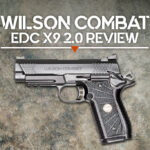
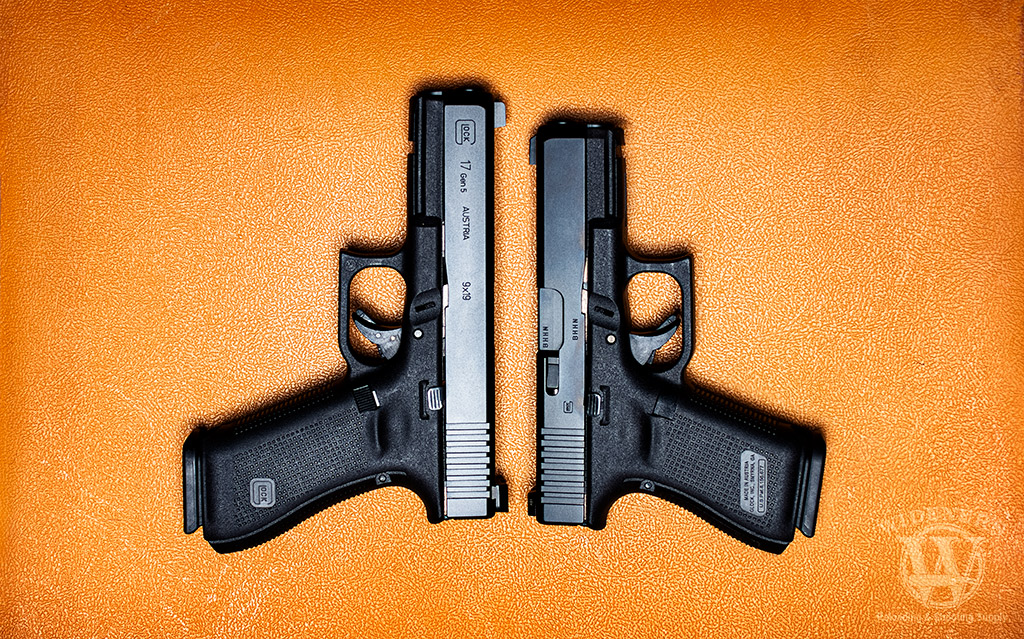
Author: Jacob Long
In 1995, Atlanta advertising agency Indelible pitched a one-word ad campaign to Glock founder Gaston Glock. The word? Perfection. It stuck and became synonymous with the minimalist brand and its polymer-framed pistols. Although popular as a service pistol in Europe, Glock failed to break into the US market until 1988. American gun enthusiasts weren’t initially sold on the idea of a “plastic” gun for safety and reliability.
Gaston’s plan for a US invasion didn’t involve flashy advertising, instead, he opted to reach out to police departments. The late 1980s were the height of the so-called “war on drugs.” Police departments were often outgunned by street gangs and unable to upgrade weapons due to a lack of funding. Gaston recognized the need for a modern service pistol and began offering the Glock 17 to police departments at discounted rates.
The strategy paid off for the Austrian inventor, soon police departments across the US were ditching old service models in favor of the Glock 17. Officers liked the increased capacity, lightweight frame, and easy maintenance of the semi-automatic handgun. The consumer market soon took notice and Glock-mania was born. Five generations of Glock models later, the demand for Glock pistols shows no signs of slowing down.
Glock 17 History
Introduced in 1982, the Glock 17 is a simple design made from 36 parts. The standard size, semi-auto pistol features a polymer frame with a locked breech. It’s a short-recoil operated pistol, meaning it uses the energy of the slide recoil to cycle the action. The standard double-stack magazine holds 17 rounds plus one in the chamber. The G17 is a popular option for military, law enforcement, home-defense, target shooting, and competition.
Glock 19 History
The compact size Glock 19 took the market by storm with its introduction in 1988. It has many of the same attributes and parts as the G17, but in a lighter, more compact design. The standard double-stack magazine holds 15 rounds plus one in the chamber. The G19 can accept the G17 magazines, although the compatibility does not go both ways. The G19 is a popular option for military, law enforcement, self-defense, and concealed carry.
So how do you decide between buying the Glock 17 VS 19? Both are proven performers in accuracy and reliability by independent tests and on the battlefield. For a better understanding of the capabilities of these two guns, we’ll take a closer look at the core characteristics they share. How do these standard and compact-sized Glocks stack up against each other? Let’s dive in and take a look.
Glock 17 VS 19: Side By Side Comparison
Comparisons between the Glock 17 VS 19 come down to size vs capacity. With nearly identical specs, neither gun offers a clear advantage over the other. The decision comes down to the user’s intended purpose.
For those wanting to conceal carry, the decision is more obvious, the smaller Glock 19 has the advantage. Glock obviously had this in mind when they designed the double-stack pistol as a compact option. For those wanting a home defense weapon, the decision is harder. The standard size G17 offers more capacity, while the compact G19 offers a slight weight advantage. Both guns have Glock MOS machined slide options for owners wanting to add a red dot optic.
Glock 17 and Glock 19 Specs
| Glock 17 | Specs | Glock 19 | Specs |
| Caliber | 9x19mm | Caliber | 9x19mm |
| Barrel Length | 4.49″ | Barrel Length | 4.02″ |
| Overall Length | 8.03″ | Overall Length | 7.28″ |
| Slide Length | 7.32″ | Slide Length | 6.85″ |
| Width Overall | 1.34″ | Width Overall | 1.34″ |
| Height W/ Mag | 5.47″ | Height W/ Mag | 5.04″ |
| Avg Weight Loaded | 32.28 oz / 2.01 lbs | Avg Weight Loaded | 31.04 oz / 1.94 lbs |
| Avg Trigger Pull | 5.5 lbs | Avg Trigger Pull | 5.5 lbs |
| Capacity | 17+1 | Capacity | 15+1 |
| Sights | White Dot/GNS/Ameriglo | Sights | White Dot/GNS/Ameriglo |
| Finish | Black nDLC | Finish | Black nDLC |
| MSRP | $599 | MSRP | $599 |
The first thing that’s noticeable is the size difference between the two handguns. Looking at the two pistols side by side, they appear to have comparable dimensions, except the G17 slide, which is noticeably longer (G17 7.32″ vs. G19 6.85″ Slide Length). The G17 is also taller (G17 5.47″ vs. G19 5.04″ Tall) with a magazine in place.
Both Gen5 model pistols feature an accessory rail for mounting a light or laser. Older Gen1 and Gen2 models of the G17, and Gen2 models of the G19 do not feature an accessory rail.
The G19 has the compact size advantage, although the G17 isn’t much bigger and has an ammo capacity advantage. However, the compact G19 is recommended over the G17 for carrying concealed.
G17 VS G19 Weight Comparison
The Glock 17 is 10.5% heavier (G17 33.33 oz / 2.01 lbs vs. G19 31.04 oz / 1.94 lbs) than the G19 when loaded. When both guns are weighed with empty magazines, the G17 weighs only 1.34 oz more than the G19.
Both guns feel well-balanced in the hand when loaded. The weight is well distributed and eliminates the front and top-heaviness of the smaller sub-compact models.
The G19 has a slight edge in weight over the G17, but it comes at the cost of decreased ammo capacity.
Pistol Widths Compared
The overall width of the G17 & G19 are identical (G17 1.34″ vs. G19 1.34″). Visually, because of the length of the slide, the G17 looks slimmer when holding the pistols side-by-side. Don’t let it fool you, both pistols also feature the same slide width (G17 1.00″ vs. G19 1.00″). Both pistols feature a beavertail on the rear of the frame, both also offer optional accessory backstraps to change the grip curve.
The G17 has a longer grip, giving those with large hands increased stability. The magazine release on both pistols is set up for thumb release by right-handed shooters. It can be easily reversed with a flat-head screwdriver and needle-nose pliers for lefties. If size matters, the compact G19 has a slight edge. If you prefer in-hand stability, the G17 comes out on top.
Glock 17 and G19 Ergonomics Compared
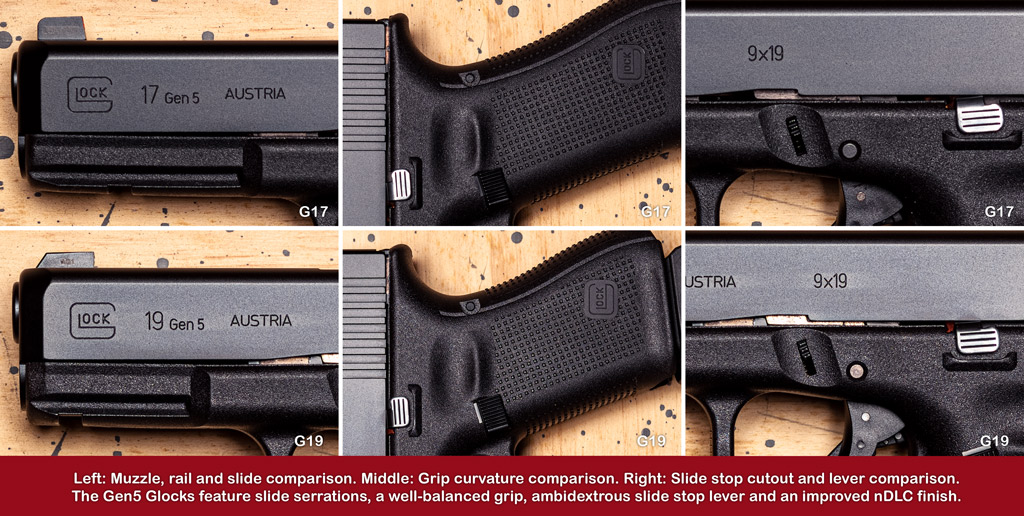
The ergonomics of both Gen5 pistols are excellent, the elongated G17 grip works well for those with larger hands.
The updated standard grip of both pistols fills the hand nicely. I welcome the evolution of improvements to the Gen5 pistols. Gone are the one-size-fits-none finger grooves of yesteryear from the grips. The aggressive texturing, shape, and girth of the Gen5 grips make both handguns a pleasure to shoot at the range. The flared mag well is also a nice new addition, Glock magazines from any previous generation slide in easily.
Both Gen5 pistols now feature ambidextrous slide stop levers. It’s an improvement, but they still lack the texture, or convex shape that many superior aftermarket options offer. Unfortunately, the slide lock shape is the same as previous models and remains difficult to lower for disassembly. The Gen5 slide has a more rounded front-end than previous models with standard rear serrations. As of 2020, all Glock Gen5 models also feature standard front slide serrations.
Pistol Barrels Compared
The Glock G17 features a 4.49″ Glock Marksman Barrel (GMB), the G19 features a 4.02″ Glock Marksman Barrel (GMB). Both (GMB) barrels are factory standard options. Glock claims to have improved the rifling and modified the barrel crown on Gen5 models for increased precision accuracy.
The G17 and G19 barrel walls are both (2.5mm) having the same thickness. The rifling and crown work on both barrels appears to be the same, the ramp on the rear of both barrels appears to be the same. In hand, the G17 barrel feels slightly heavier than the G19 barrel. Both pistols are very accurate on the range, it would be hard to give an advantage to either pistol at standard distances out to 50 yards.
Trigger Distance Compared
For my large hands, the 2.76″ trigger distance is workable with the factory grips. My index finger found the trigger easily from the front of the trigger guard when drawing both pistols. If you have large hands, adding a backstrap accessory may make the grip more comfortable. Be aware that adding a backstrap to your pistol may change your natural point of aim.
Trying to decide between the Glock 17 VS 19? If you have smaller hands, I’d recommend trying both pistols before you decide to make a purchase. You should be able to easily reach the trigger without having to uncomfortably stretch your fingers. Both pistols have a shorter trigger distance than the subcompact G26 model (G17 & 19 2.76″ vs. G26 2.83″). In comparison, the compact G48 and G43X models have a shorter trigger distance than the standard G17 and compact G19 models (G48 & G43X 2.64″ vs. G17 & 19 2.76″).
Sight Radius Compared
The standard line of sight on the G17 is 6.5″ in length, while the G19 is 6.02″ in length. It may seem like a small difference, but at the range, a distance of a few millimeters can mean a difference of several inches in hit accuracy at a distance of 25 yards. On targets at distances of 50 yards or greater, a few inches can become several feet of bullet deflection with the slightest movement by the shooter.
In theory, a longer sight radius allows for better accuracy. A longer sight radius allows you to see sight alignment errors more easily and correct them in realtime. That concept works well in a controlled environment while shooting from a bench rest with the pistol mounted on a stable surface. In the real world, the accuracy of a gun depends on the ability of the person firing it. If you want exceptional technical accuracy from your pistol, take it to the range and train with it.
Holster Drawing
Drawing from a Kydex holster in the appendix position, both guns are easy to grip, draw and reholster. The elongated grip of the G17 gives you more real estate for drawing. However, the extra length can also cause your hand to search to find the correct draw position. I found my hand hitting lower on the grip than I intended, an issue I didn’t have with the compact size G19.
I performed a drill of five holster draws, five shots fired @15 yards with both pistols on a standard USPSA target. After sending 25 rounds downrange with both pistols, I found both to be equally comfortable to hold and fire. Glock perfection? More like Glock reliability. With more than a million pistols sold in the US alone, the minimalist Glock design delivers every time you pull the trigger.
Concealed Carry Dynamics
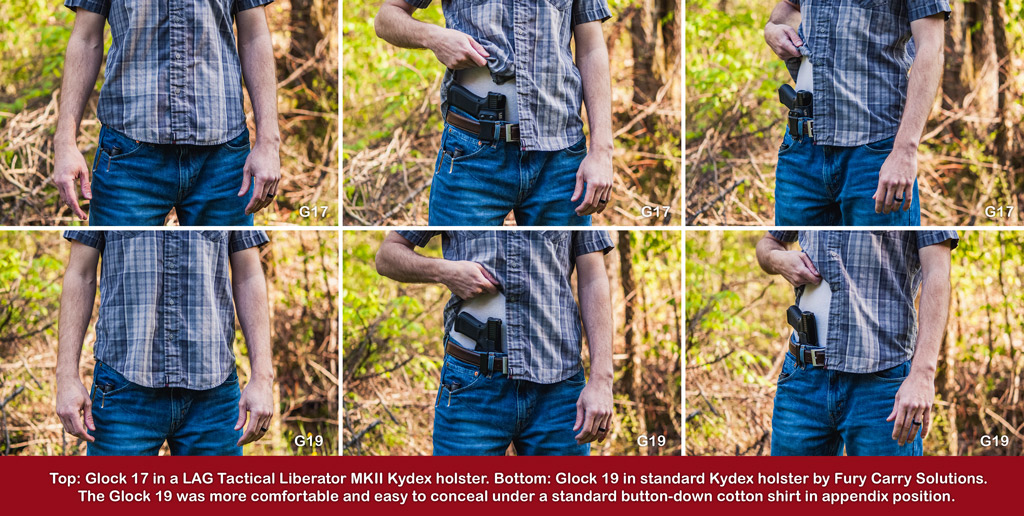
Standard sized pistols like the G17 are easier to conceal in layered winter attire vs. thin summer clothing.
I carried both pistols for a full day, on two different days, doing all of my normal daily activities. Both pistols were appendix carried IWB, in Kydex holsters with a full magazine, in condition one, in the two o’clock position. The G17 was in a LAG Tactical Liberator MKII holster, the G19 was in a Fury Carry Solutions Appendix Series holster. Both holsters are similar in shape and size. They also have an MSRP of about the same price depending on the build options you choose.
So if you’re looking to carry the Glock 17 VS 19, what are my thoughts? I didn’t enjoy carrying the GIock 17 concealed. Even with a good gun belt and holster, the extra weight of the loaded gun caused my pants to sag in the front. I found myself continuously readjusting my pants throughout the day. I also found my wrist (above my thumb) consistently hitting the butt of the gun each time I needed access to my keys or a knife in my pocket. The G17 isn’t drastically larger than the G19, but I was more than happy to swap it the next day for testing.
Despite similarities, the compact G19 is 8.5% shorter in height and 9.2% shorter in length than the G17. It also weighs 10.5% less when loaded. As noted, the size and weight difference isn’t considerable, but it is consequential. A little can be a lot. Case in point, I’m still comfortably carrying the G19 concealed as I type this comparison. Of course, your results may vary depending on your body shape and size.
Glock 17 VS 19: Ballistics Testing

Glock 17 VS 19: Both pistols were both tested with 124gr and147gr JHP self-defense ammo at the range.
I set up a ballistic chronograph at the range to test two popular self-defense ammo loads. I shot ten rounds of Speer Gold Dot 9mm JHP 124gr +P and ten rounds of Federal HST 9mm JHP 147gr through both pistols. The recorded data from the chronograph was captured at a distance of about 10′ with a calibrated unit. Being known for reliability and mechanical accuracy, both pistols performed extremely well while cycling the self-defense ammo. I had no issues with feeding, firing or ejecting rounds from either brand of ammunition.
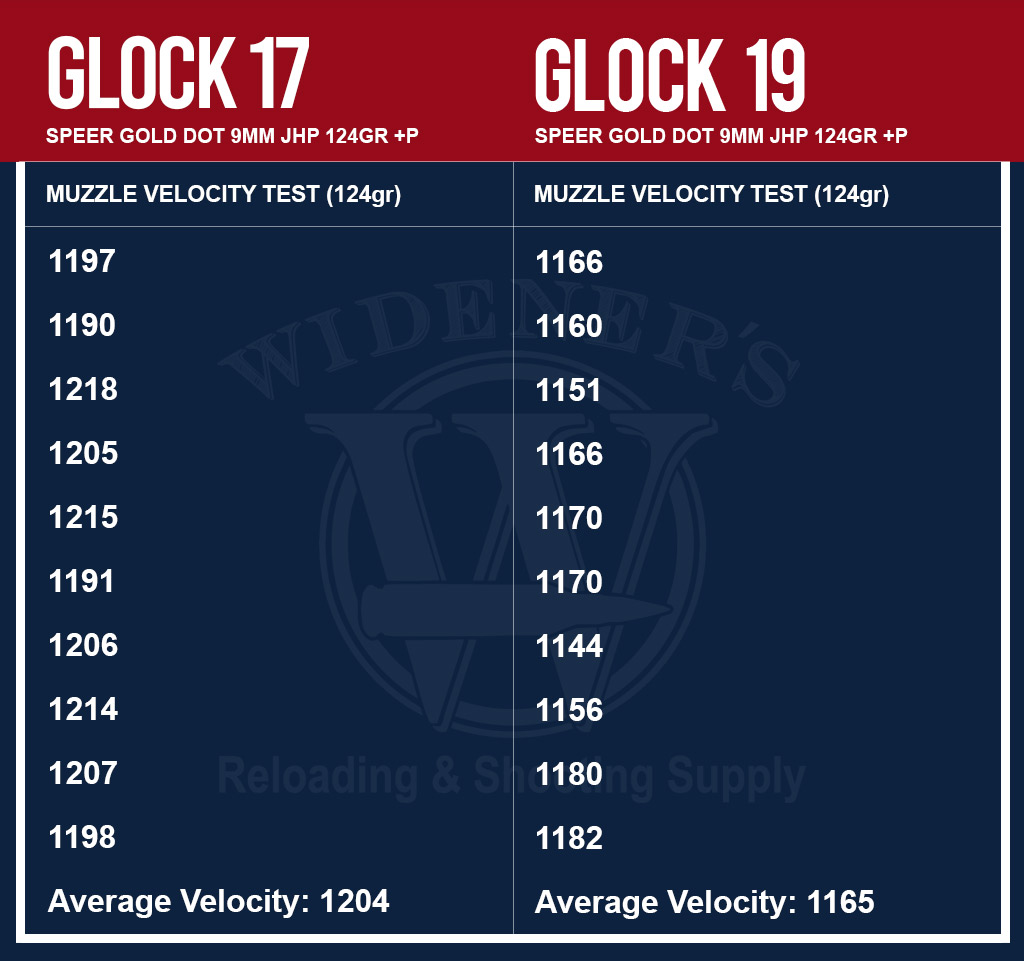
The longer barrel of the Glock 17 produced a higher average velocity with the Speer Gold Dot 9mm JHP 124gr +P ammo.
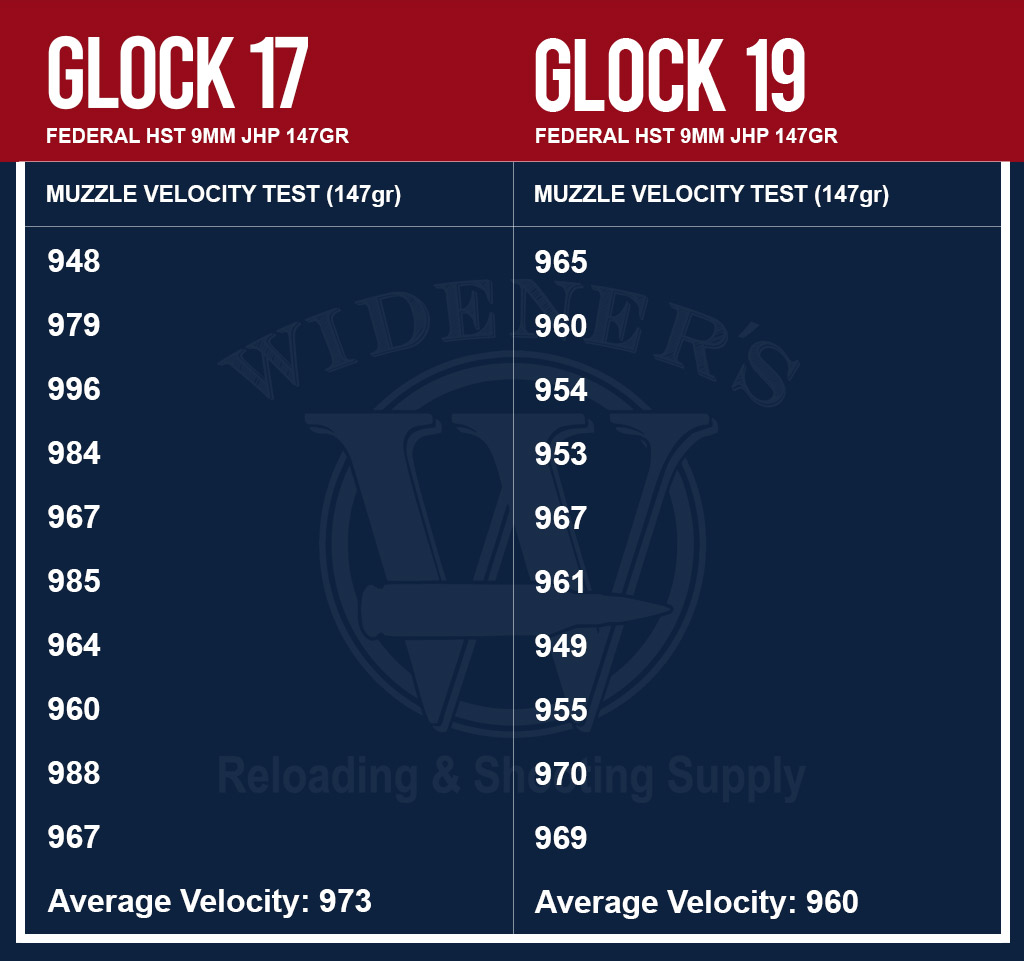
Both guns were able to keep Federal HST 9mm JHP 147gr ammo at subsonic speeds well below 1,126 fps.
Muzzle Velocities
In the G17, the Speer Gold Dot 9mm JHP 124gr +P pushed an average velocity of 1179. The G19 finished with an average of 1181. With the heavier subsonic Federal HST 9mm JHP 147gr loaded the G17 had an average velocity of 967, while the G19 averaged out at a velocity of 964. In conclusion, based on the data, we have another draw. The G19 handles the velocity of the 124gr +P loads a little better. The longer barrel of the G48 handles the heavier 147gr ammo at a velocity a little closer to the advertised manufacturer box speed.
The Followup Shot: Recoil Compared
Without using scientific measurements, I will describe my experiences shooting both pistols. With Fiocchi 115gr FMJ loaded, both pistols performed admirably. Felt recoil was low, muzzle rise was minimal. I had no issues making quick followup shots on target with both pistols. I would say both pistols performed above their price range in recoil management with range ammo. Recoil management is above average, even when compared to other similar polymer-frame, or metal-frame pistols from competitors.
The felt recoil with the Speer Gold Dot 9mm JHP 124gr +P loaded was more noticeable. I felt a stronger vibration in the grip of the G19 when firing this hot round. Both pistols experienced greater muzzle rise with +P ammo, producing slower followup shots at the range. Both pistols handle recoil very well, I wouldn’t say that either has a clear advantage. My recommendation would be to spend time training with the ammo you plan to use with the pistol. Learn the strengths and weaknesses of both, and adjust your shooting strategy accordingly.
Ammo Capacity & Compatability
Capacity can be a discussion about limitations, or the potential of a weapon’s ability to hold ammunition. Glock, and numerous third-party manufacturers, offer a variety of different magazines for both pistols. They include magazine options capable of holding 17, 24, 31, and 33 rounds or more. It’s possible to customize either weapon with an extended magazine to give it the capability needed for accomplishing a specific task. In that regard, with increases to size and weight, the capacity potential of both handguns is equal.
If we are discussing limitations of capacity, the conversation centers around the standard number of rounds a pistol can hold without increasing the size or weight of the handgun. The 17+1 capacity of the G17 is a part of the legacy of the standard size, double-stack pistol. However, the 15+1 standard capacity of the compact G19 also offers owners a respectable amount of ammunition. Does an extra two-round capacity really make a difference? It can, but it’s unlikely for most owners that it would.
When it comes to magazine compatibility, the G19 wins hands down. The G19 has full compatibility with G17 and G19 magazines. It does not have compatibility with subcompact model G26 magazines, or G43/X/G48 magazines. Unfortunately, Glock magazine compatibility doesn’t always go both ways. The G17 only has compatibility with its own magazines.
Glock 17 VS 19: Which Gun Should You Buy?
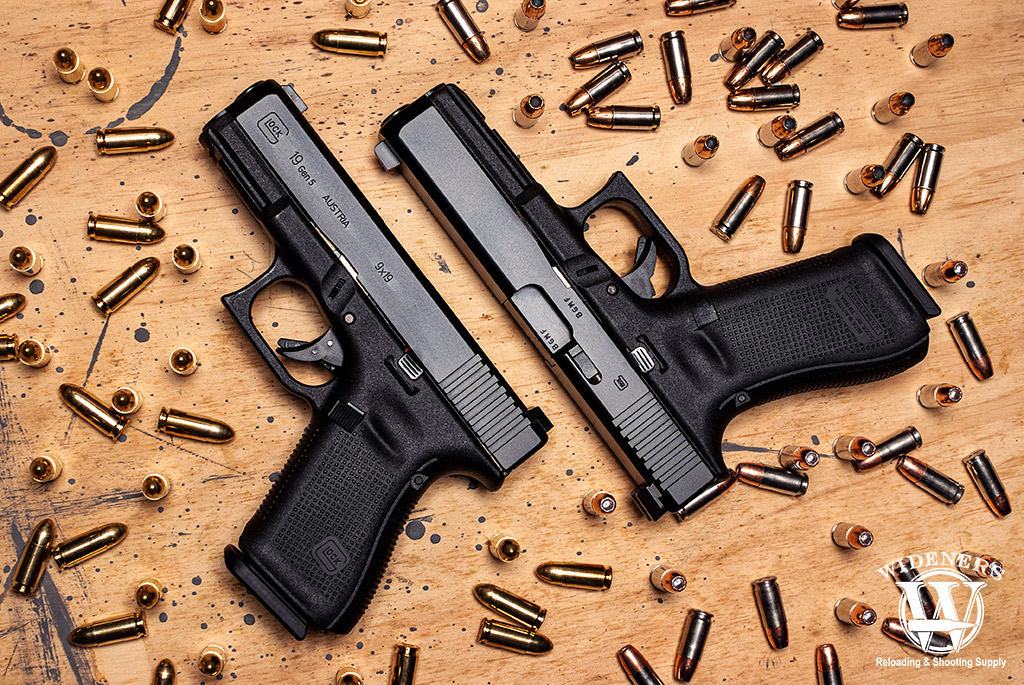
The results of practical evolution are evident in each Glock generation, resulting in improved handgun options for the consumer market.
If your primary objective is to purchase a gun for home defense, the Glock 17 is an exceptional value. Considering all of the Gen3, Gen4 and older Glock models on the market, it’s fairly easy to find a good deal on a previous generation Glock. If you are a competition shooter looking for a high-capacity handgun, the standard two-round extra capacity of the G17 is a plus. If you prefer a pistol with a longer sight radius, or have large hands and need a longer grip, the G17 is the way to go.
On the other hand, the Glock 19 has many of the same features as a G17, albeit in a more compact package. If your primary objective is to purchase a gun for concealed or everyday carry, the Glock 19 is an exceptional value. When it was introduced in 1988, the G19 changed the direction of the industry. There’s a reason it’s one of the most copied and best-selling handguns of all-time. It does everything well, with no real compromises. If you need one gun, that’s capable of handling a wide range of applications, the G19 is your best option.




